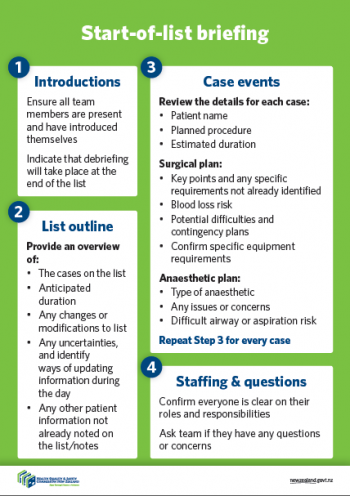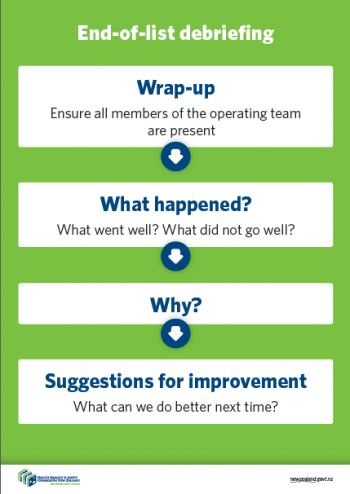There is strong evidence to support the use of surgical briefings and debriefings to reduce patient harm.
In a 2015 article in the Australian and New Zealand Journal of Surgery, Civil and Shuker note that ‘briefings and debriefings in the theatre environment have reduced communication failures by two-thirds, reduced non-routine events by 25 percent, effectively surfaced potential surgical safety hazards, reduced staff perception of risk and increased their sense of team collaboration, and in a Johns Hopkins study, reduced unexpected delays by 31 percent and surgeon-reported unexpected delays by 82 percent’.[1] There is also a powerful link between routinely undertaking briefings, and the safety culture within the operating theatre.[2]
 Briefing
Briefing
Briefings enable the sharing of the operative plan, promote teamwork, mitigate hazards to patients, reduce preventable harm and ensure all equipment is available. They supply a broader knowledge base for the planned procedure so each team member has a better understanding of the tasks at hand, and can anticipate future events and pre-plan accordingly.
The briefing is a standardised communication tool that aims to create an environment in which individuals can speak up and express concerns, and alert team members to unsafe situations in a timely manner. It is recommended that surgical teams take the time prior to the start of each day's operating theatre list to complete the team briefing.
The poster on the wall guides the briefing over four steps:
- team introductions
- list outline
- case details for each case
- staffing and questions.
We recommend that the person who knows the most about the list and the patients, leads the briefing.
 Debriefing
Debriefing
Debriefings enable teams to take time to learn from real-time situations that went well or didn’t go to plan by discussing what happened after an operating session. They provide opportunities for improvement, learning not blaming, improvement in staff wellbeing and a forum to say thank you. In a 2014 study in Florida, the participating hospital found that debriefing supported continuous process improvement by encouraging each team member to creatively identify solutions to issues encountered during the perioperative period.[3]
A five-minute debriefing should be completed in theatre at the end of the patient list. The poster on the wall prompts the discussion. The debriefing is completed verbally. It will be important to capture informally any actions arising from the debriefing to ensure that identified issues are resolved and suggestions for improvement acted on.
During the debriefing team members are encouraged to raise any concerns or suggestions they may have had during any of the operations on the list. Discuss what went well and not so well, what can be improved or done better next time, and why.
As part of debriefing, organisations must implement some kind of action-feedback loop for instances where changes or improvements need to be made. It is essential that learnings from debriefings are acted on, or the use of the tool will diminish.
Resources
The programme has developed briefing and debriefing posters for use in operating theatres. Some hospitals have developed their own versions.
References:
- Civil, I., and Shuker, C. 2015, Briefings and debriefings in one surgeon’s practice. ANZ J Surg 85 (2015) 321–323
- Allard, J. et al, Pre-surgery briefings and safety climate in the operating theatre. BMJ Qual Saf. 2011 Aug;20(8):711-7.
- Marks S, et al. 2014. Surgical team debriefing and follow-up: creating an efficient, positive operating room environment to improve patient safety. APSF Newsletter. Indianapolis: Anaesthesia Patient Safety Foundation
